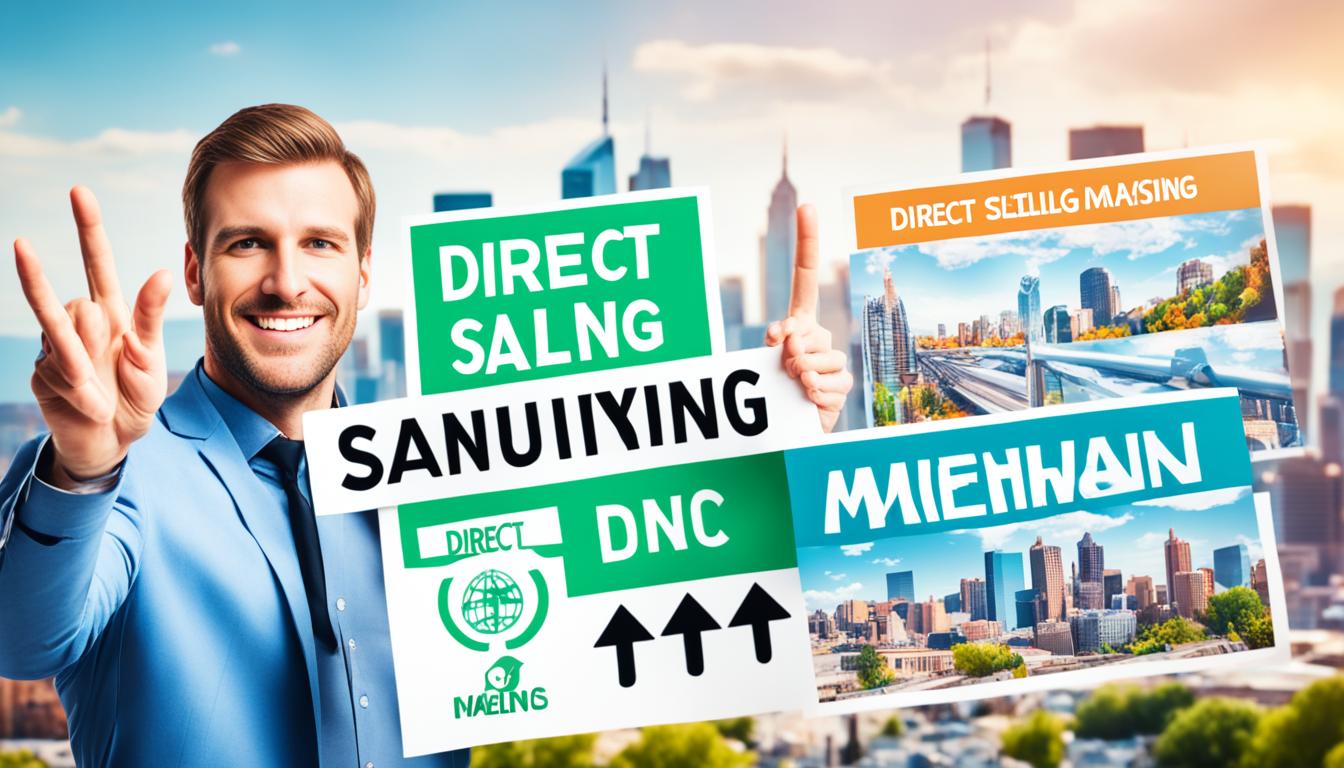Welcome to our guide on crowd marketing. This strategy uses online word-of-mouth to increase your brand’s visibility. We’ll cover what crowd marketing is, its benefits, and give examples of its success. It’s perfect for startups wanting to build their brand. Big companies can also use it to gain social proof and user content. Let’s explore how crowd marketing can revolutionize your marketing.
Key Takeaways:
- Crowd marketing leverages online word-of-mouth and community engagement to promote your product directly to your target audience.
- By participating in industry-specific forums, social media networks, and review platforms, marketers can shape positive impressions and drive interest in their brand.
- Crowd marketing offers advantages such as increased brand awareness, customer engagement, and the expansion of your customer base.
- Real-world examples, like Marufuku Ramen and Doritos’ Crash the Super Bowl campaign, highlight the success and effectiveness of crowd marketing strategies.
- Crowdsourcing is a related concept that involves obtaining work, information, or opinions from a large group of people via the internet and social media.
How does crowd marketing work?
Crowd marketing lets marketers talk to their audience naturally through discussions online. They join in conversations on different websites and social media. This helps create a good image, gets people interested, builds brand awareness, and brings more visitors to their website.
First, marketers figure out who they want to reach and where to find them. They look for the best places online, like review sites, forums, blogs, and social media. This is where they’ll talk to their audience.
Then, they start joining in on talks about their brand. They share what makes their brand special in a real and polite way. This helps them connect with people and builds trust.
Crowd marketing is all about real talk and what users say, not just ads. It uses real recommendations and word-of-mouth. This feels more real to people and can turn them into fans and loyal customers.
This approach helps brands use their audience’s knowledge and influence. It drives interest, boosts web traffic, increases visibility, and makes the brand stronger.
With a good crowd marketing plan, brands can really engage with their audience. They can start meaningful talks and attract new customers. Understanding crowd marketing can help companies stand out and succeed over time.
Advantages of Crowd Marketing
Crowd marketing has big perks for both new and established businesses. It helps grow brand awareness, builds trust and authority, and widens the customer circle.
Generating brand awareness is a huge plus of crowd marketing. By using influencer marketing and online buzz, companies of all sizes can leverage social proof. User-generated content helps spread the word about their offers. Engaging with people on forums, social media, and review sites creates brand buzz and boosts visibility.
Another advantage is better brand engagement. Companies get to talk directly with their audience by joining in on natural discussions about their products or field. This lets them share what makes their products special, answer questions, and connect with potential buyers.
Crowd marketing also helps companies reach more customers. It boosts brand awareness, sparks interest in products, and builds credibility. This draws in a bigger audience and ups the number of people checking out what a company offers. Using smart crowd marketing tactics, firms can turn leads into customers and inspire customer referrals.
In summary, crowd marketing is a key strategy for both new and big companies wanting to up their game. It boosts brand recognition, engages customers, and brings in more business. By making the most of the crowd, companies can carve out a strong space in their market and grow steadily.
Examples of Crowd Marketing
Brands use crowd marketing by leaning on customer reviews. Sites like Yelp, Facebook, and Google let people talk about their experiences. This helps others make choices that are well-informed. Marufuku Ramen, a beloved ramen spot, boasts nearly 4000 reviews from customers. These reviews act as strong social proof, drawing in more diners through glowing recommendations.
Amazing Lash Studio, a well-known eyelash extension salon, shows another way to do crowd marketing right. They keep the lines of communication open by responding to all customer feedback. This approach helps resolve issues and keeps customers feeling valued and heard.
Let’s look at how customer reviews play a role in crowd marketing with a quick comparison:
| Brand | Number of Customer Reviews | Positive Reviews | Negative Reviews |
|---|---|---|---|
| Marufuku Ramen | Almost 4000 | 92% | 8% |
| Amazing Lash Studio | Over 5000 | 87% | 13% |
The table gives us a side-by-side look at Marufuku Ramen and Amazing Lash Studio. It compares their customer review counts, and the share of positive versus negative feedback. These numbers highlight how crowd marketing can lead to more positive views of a brand, enhancing its reputation.
What is Crowdsourcing?
Crowdsourcing gets work, info, or opinions from many people via the internet, social media, and apps. It lets companies use the diverse skills of folks without hiring. It’s popular because tech makes it easy and efficient. This allows businesses to tap into a crowd’s collective brain for tasks and projects.
Companies can get valuable insights and ideas from a wide range of people through crowdsourcing. It brings the power of the crowd, giving diverse viewpoints and new solutions. It’s used for things like app creation, copywriting, and ad design. Crowdsourcing helps businesses achieve goals in a cost-effective, efficient way.
Benefits of Crowdsourcing
Crowdsourcing offers companies several advantages:
- Access to lots of people: It lets organizations reach a huge pool of talent, bringing a wide range of skills and knowledge.
- Cost savings: Companies can get tasks done by the crowd, saving money on hiring.
- Rapid turnaround: Crowdsourcing gives businesses quick solutions, speeding up project completion.
- High-quality results: The crowd’s collective intelligence often brings innovative and superior outcomes.
- Better customer engagement: Including customers in the process builds loyalty and a strong company-audience relationship.
Examples of Crowdsourcing
Many companies have used crowdsourcing successfully. Here are some examples:
| Company | Description |
|---|---|
| Waze | Waze uses crowdsourced traffic data from users for real-time updates, helping with better route guidance. |
| Unsplash | Unsplash provides free, quality stock photos from photographers worldwide, aiding designers and marketers. |
| Contently’s Freelance Rates Calculator | This tool uses crowdsourced data to help freelancers set fair rates, promoting transparency in the industry. |
| Doritos’ “Crash the Super Bowl” | This campaign had consumers create Super Bowl ads, using their creativity for brand promotion. |
| Airbnb | Airbnb’s platform has hosts offer rental places to travelers, providing unique, affordable stays around the world. |
| PepsiCo | The “Do Us a Flavor” campaign got new chip flavor ideas from consumers, engaging them in the creation process. |
Crowdsourcing Examples
Crowdsourcing is a powerful tool used by many companies. Let’s explore some notable examples:
Waze
Waze is a popular navigation app that uses crowdsourced traffic data. It gathers information from millions of drivers in real-time. This allows Waze to give accurate traffic updates and suggest the best routes, saving users time.
Unsplash
Unsplash offers a vast library of free, high-quality stock photos. Photographers worldwide contribute their work. This allows businesses and individuals to find stunning visuals for their projects without high costs.
Contently’s Freelance Rates Calculator
Contently’s Freelance Rates Calculator is great for freelancers who want fair pay. It uses crowdsourced data on industry standards and rates. This helps freelancers negotiate confidently, ensuring fair compensation.
Doritos’ Crash the Super Bowl
Doritos’ “Crash the Super Bowl” contest showcases crowdsourcing in advertising. Consumers are invited to create their own Super Bowl ads. The best ones might be shown during the game.
Over the years, Doritos has received thousands of submissions. This strategy generates buzz, boosts brand engagement, and builds a community among fans.
Airbnb
Airbnb’s business model relies on crowdsourcing rentals. It allows people to list their properties or rooms on their platform. This gives travelers unique accommodation options all over the world and helps property owners earn money.
PepsiCo’s “Do Us a Flavor” Campaign
PepsiCo’s “Do Us a Flavor” campaign crowdsources ideas for new chip flavors. Consumers submit their own flavor suggestions. This keeps PepsiCo’s products fresh and engages the audience.
These examples show how versatile and effective crowdsourcing is. Companies in different industries use the crowd to improve their products, services, and marketing. By engaging a large, diverse group, businesses can innovate, engage their audience, and stay competitive.
How to Crowdsource
For effective crowdsourcing, companies must follow a series of steps. They need to design the task, make promotional materials, pick a strategy to promote, manage the outcomes, and create the final product. Doing this lets businesses tap into crowd power for great results.
Design the Job
To start crowdsourcing, first design the job. Be clear about what you aim for and what actions are needed. It could be asking for ideas, creating content, or solving issues. A well-planned task makes sure everyone understands and focuses.
Create Promotional Materials
Promotional materials are key to getting the crowd’s attention. Use visuals and social media ads to share your message and spark interest. Make materials that catch the eye and clarify the value and benefits of joining in.
Choose a Promotional Strategy
It’s crucial to pick the right promotional strategy to reach your audience. Find out where your audience spends time and customize your approach. Use social media, influencers, or ads to make your crowdsourcing project very visible.
Manage the Results
Managing the outcomes is vital during crowdsourcing. This includes reviewing entries, giving feedback, and picking the best ideas. Have clear criteria for evaluation and be fair to keep participants happy and engaged.
Produce the Final Project
After picking winners or top contributions, it’s time to make the final project. Work with the chosen folks to execute the idea. Good collaboration and communication result in a successful project with high-quality results.
By following these steps, businesses use the crowd’s intelligence and creativity. This leads to innovative solutions, new ideas, and valuable insights for companies.
| Step | Description |
|---|---|
| Design the Job | Determine the objective and actions for the crowd |
| Create Promotional Materials | Develop visually appealing assets to attract participants |
| Choose a Promotional Strategy | Select platforms and channels to reach the target audience |
| Manage the Results | Evaluate submissions, provide feedback, and select winners |
| Produce the Final Project | Execute the chosen design or idea with selected participants |
Crowdsourcing opens endless possibilities for organizations, inviting collective wisdom and innovation. Through a strategic and systematic approach, companies achieve goals and create significant impacts using crowdsourcing.
Crowdsourcing Sites
Companies can choose from many crowdsourcing sites to get a lot of people involved. Amazon Mechanical Turk is one popular choice. It’s a marketplace for companies that need tasks done, like checking data or moderating content. This platform lets businesses reach out to many workers. This way, they can get their projects done efficiently. It’s great for tapping into the smarts and abilities of many people.
There are other crowdsourcing sites too, each with its own special features. They offer services like graphic design, video editing, translating, and doing market research. Based on what they need, businesses can pick the perfect platform. They get high-quality work done by skilled folks.
Crowdsourcing sites are super useful for businesses that want to make use of the crowd’s power. They find people with the right skills for their projects. Using these platforms helps businesses manage their work better. They can use their resources wisely and achieve their goals.
It doesn’t matter if they choose Amazon Mechanical Turk or another site, companies have lots of chances to work together and create something new. These sites let them use the crowd’s knowledge and talents. This boosts their chances of doing well.
Conclusion
In conclusion, crowd marketing and crowdsourcing are very helpful for businesses. They help increase brand awareness, engage customers, and save money. These strategies use the crowd’s power to help companies grow.
Businesses use crowd marketing to reach their audience on forums and social media. They create a positive image and spark interest in their products. This boosts website visits and enhances online visibility. Examples like Marufuku Ramen and Doritos’ Super Bowl campaign show how effective it can be.
Crowdsourcing lets companies find talented people without needing to hire more staff. It’s great for projects like app development, writing, and ad design. Waze, Unsplash, and Contently’s Freelance Rates Calculator are examples of successful crowdsourcing.
Together, crowd marketing and crowdsourcing help businesses connect with people, get more visibility, and succeed in marketing. Using these approaches, companies can harness the crowd’s power for growth and stay competitive in the market.




